All-in-one version
Director’s Corner
Focus on our Four Foundational Principles
Greetings, Caltrans colleagues. Thank you to those who have come together to show support for the family of Ali Shabazz, a District 6 civil engineer who, tragically, was killed in a vehicular crash on Aug. 8 in Fresno County. Please read about Ali in this e-newsletter, and consider making a donation to the Ali Shabazz Memorial Fund that was created by the California Transportation Foundation (CTF).
Please also take the time to look over the rest of this latest issue of CT News. I look forward to connecting with you on a regular basis in this space, complementing my department-wide, monthly emails. Both messages speak to my commitment as director to provide transparent, valuable updates directly and consistently.
The Director’s Message updates will mostly focus on our Four Foundational Principles: Safety, Equity, Climate Action and Economic Prosperity in our Communities. As I have emphasized before, these tenets are not abstract concepts, but rather the concrete framework guiding all our plans and projects.
Recently, I introduced the fourth principle—Economic Prosperity in our Communities—by stressing that the confluence of jobs, housing, safety, a clean environment and access helps deliver the substructure necessary for a community to thrive economically. Here at Caltrans, we must endeavor to plan equitable, sustainable and safe projects that provide meaningful access for all Californians regardless of ZIP code. Caltrans has already made tremendous strides in helping our communities. Through funds generated by Senate Bill 1(SB 1), we have completed 4,000 projects and have another 4,500 planned or in progress, and we can point to the creation of more than 200,000 jobs. Governor Newsom’s 2022-23 state budget includes $1 billion General Fund dollars for Active Transportation Program projects that encourage the increased use of active modes of transportation—such as walking and biking—and increase the safety and mobility of non-motorized users.
And our year-old Clean California program is making a profoundly positive difference in our communities. So far, we have collected more than 750,000 cubic yards of trash, and before year’s end that total should grow past 1 million. The progress we are making is evident and, by design, highly beneficial to all.
My next monthly director’s message will spotlight our Equity principle. When equity is built into culture, project plans, and all related action, it sets in place a level playing field that every person deserves in their daily life. This is an area in which we, as a transportation department, play a tremendous part.
Many good things are happening on multiple fronts, and I am grateful for all you are doing to make Caltrans the nation’s top transportation department. Let’s continue to focus on our 4 Foundational Principles and, from this important cornerstone, achieve even more on behalf of all Californians.
News
Civil engineer Ali Shabazz killed in collision

Ali Shabazz
Photo courtesy of the familyNote: The California Transportation Foundation has established a memorial fund for Ali Shabazz. Please visit the fund's webpage and consider making a donation. The following press release was distributed by Caltrans on Aug. 8.
The California Department of Transportation (Caltrans) is mourning the death today of Ali Shabazz, 48, a Civil Engineer for the department. Shabazz was killed while on duty when he was involved in a fatal vehicle collision in Fresno County.
Shabazz had served Caltrans for more than 16 years, joining the department in 2006. He is survived by his wife, Nia, and their eight children.
“The tragic death of Caltrans District 6 veteran Ali Shabazz is a devastating loss to his wife, their eight children, and our entire Caltrans family,” said Caltrans Director Tony Tavares. “I extend my heartfelt prayers and deepest sympathy to Ali’s family and all who knew and worked with him.”
Just before midnight, Shabazz was traveling to a job site when his vehicle was struck by another vehicle at a rural intersection. He succumbed to his injuries on-scene.
Gov. Gavin Newsom also extended his sympathies.
“Jennifer and I were very saddened to learn of the untimely loss of Ali Shabazz, a dedicated Caltrans employee who served the people of California for more than 16 years. We offer our deepest sympathies to his family and his many friends and Caltrans colleagues during this painful time."
Shabazz is the first Caltrans District 6 (Central Valley) employee to die on the job since 1999. He is the tenth in the history of District 6 and the 191st Caltrans worker to lose their life on the job since 1921.
To assist Ali’s family, including his eight children, a memorial fund has been established through our partner at the California Transportation Foundation. Please visit the Ali Shabazz memorial fund web page to donate.
Digital Print operator makes District 10 look great
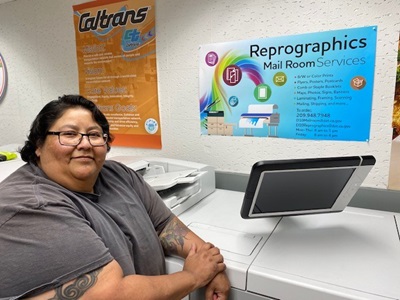
Ruby Islas works in District 10 as a digital print operator in Reprographics/Mail Services.
Photo by District 10By Bob Highfill
District 10 public information officer
District 10 is fortunate to have Ruby Islas, who runs perhaps the best print shop anywhere.
From her post inside the mailroom in the basement of the main building in Stockton, Ruby works as a digital print operator in Reprographics/Mail Services and has expert command of heavy-duty, high-tech equipment she uses to perform a variety of printing tasks that assist every facet of the department.
Ruby also handles shipping, internal mail, and incoming and outgoing mail.
Ruby shepherds the flow of communication within District 10 and creates materials, such as programs, booklets, brochures, pamphlets, and posters that different departments utilize for their purposes internally or for public outreach.
Ruby has a wide range of talents and performs her duties with a commitment to quality and detail. And she has an unrivaled work ethic.
“Ruby has embraced customer service, combined with her valuable print shop experience, and has improved the D10 Reprographics Department’s level of services to rival, and exceed, other larger district’s operations,” said Ruby’s supervisor, Bill Lavelle, creative services manager – small business, graphic design, audio visual, reprographics, web and mail room. “It really is something special.”
Ruby came to District 10 about two years ago with more than 17 years of experience working for a small family-run printing business in Sacramento. She learned quickly and took on the responsibility of running the shop shortly after she was hired. Advances in printing technology and graphics over the years meant Ruby had to continually learn new processes, which she did with enthusiasm.
“No matter what it is they try to teach you, whether it has to do with printing or not, always take advantage of it,” Ruby said. “Learn as much as you can, no matter what it is, and I kind of live by that motto.”
Ruby credits her work ethic to her late mother, Maria Martinez, a cook by trade who raised Ruby and her 16 siblings. Ruby’s father worked in agriculture, so the family moved frequently. Ruby wanted to work so she could buy her own things.
She earned a GED and started her life as an independent young woman.
Ruby saved enough money to buy a home she shared with her mother the final 25 years of her life.
“She tried to teach us to be honest, be good to people, and help people when you can,” Ruby said. “And she never turned family down.”
Ruby is honest, good to people, helps when she can, and never turns down her family in District 10. She makes District 10 look great.
Eyes in the sky: District 2 deploys drones

Scott Tikalsky controls a drone as part of his surveying activities in the Redding region.
Photo by District 2By Kurt Villavicencio
District 2 public information officer
For over 10 years, Scott Tikalsky has worked at Caltrans. As the Redding Field Surveys Branch chief for the North Region Office of Surveys, he commands four field survey crews and manages the workload for all things “survey” for Caltrans in the North state.
It’s a position that requires adaptability and implementing new technological advances that change the way Caltrans conducts business.
As drones became more common on work sites and in the public marketplace, Scott was tasked with implementing them into the Caltrans survey workflow for all projects in District 2. Drones offer a unique capability and offer benefits outside of data procurement.
“The new technologies, as they are incorporated into our workflows, greatly increase the safety factor for some of the surveying we have done manually, particularly the vertical surfaces where it is almost impossible to put someone on the side of the hill,” Scott said. “We are also able to cover larger amounts of area in a shorter amount of time and only utilize the field crews for locating items that need the accuracy of a conventional survey. It’s a workforce multiplier for us.”
From the first project incorporating a surveys drone, to the latest and greatest, the surveys team is always learning on the job, and learning how to best serve their clients.
“As far as drone projects, we are pretty new with this technology, so each project we complete … we are still learning the capabilities we have,” Scott said. “This makes each project unique as we expand our knowledge of what we can do with this technology and help out the district. The primary purpose of these drones is to provide survey data, but imagery has been a happy side product, providing a snapshot in time of a project.”
It has been a complete team effort to provide imagery to project managers, engineers, and Caltrans team members across a spectrum of specialties throughout the years. Scott takes pride in the team dynamics that have been cultivated in the Caltrans District 2 survey branch.
“I’m really proud of the people I work with. I have a branch full of good hard-working people willing to get the job done and done right,” Scott said. “The products we create are professional, high-quality, accurate assessments that can provide scope to the team working the project. It’s important work, and I couldn’t be prouder of it.”
Technology gives bridge inspections a lift
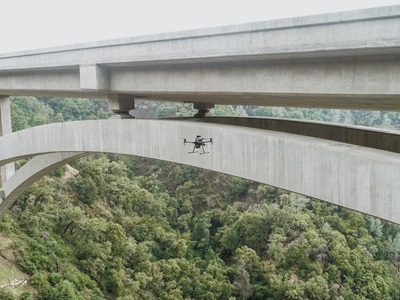
The Shasts Viaduct Bridge stands by as a District 2 drone hovers nearby
Photo by District 2By Haleigh Pike
District 2 public information officer
Under Bridge Inspection Trucks (UBITs) have been the most common tool used to gain access in difficult areas of bridges throughout California for many years. These trucks provide crews the ability to get underneath bridges to inspect areas that would otherwise be unreachable.
But with more than 24,000 bridges to inspect in California, inspectors have been seeking more efficient ways to get the job done and with the introduction of piloted mechanical eyes in the sky, they found just that.
Catherine Tarala is one of the area bridge maintenance engineers for District 2. She is responsible for 214 state owned bridges in Trinity, Plumas, and Lassen counties as well as some in Shasta County. She shares District 2 with two other area bridge maintenance engineers and together, they have a lot they’re responsible for, including performing bridge inspections and making structure work repair recommendations.
With a requirement from the Federal Highway Administration that bridges are inspected every two years, it was clear that other tools used for inspecting these bridges needed to be considered in order to be more efficient. This is when Unmanned Aircraft Systems (UAS, a.k.a. drones) were added to the force, changing the way bridge inspections are performed.
Though the use of a UAS can be limited, due to several factors including weather, landscaping, and wildlife, these eyes in the sky have already proven their ability to be an effective tool and in some cases, it is as if the inspector was in the UBIT basket. Tarala has been introducing the use of UAS in her workload for the last couple years and she says when compared to inspections done with the UBIT, there’s not many differences.
“These UAS have 4K high resolution cameras that capture superior images, so you can zoom in and look at things live while the UAS is in the air, which is somewhat the equivalent of being in a UBIT basket. The greatest benefit is that these images are stored and can be viewed at a later time if needed, something that is not possible while only using a UBIT.
“Furthermore, a UAS can take several thousand photos of a bridge in a short amount of time to create a 3D model. Structure Maintenance and Investigations is currently working on training Artificial Intelligence so that the computer can scan these models in order to aid the inspector in finding and quantifying visual defects.”
Other benefits to using a UAS is how much safer it makes the inspection, and it requires far less manpower. When setting up an inspection with the UBIT, it is often required that the local Bridge Crew is on scene to help with lane closures, which impacts traffic and causes crews to be out on the roadway. With a UAS, the pilot and inspector can stand in a safe area and operate the equipment without requiring extra manpower or impacting traffic.
While the use of UAS will never replace the ability to be able to get up and touch and inspect a damaged bridge, they are slowly becoming more common during inspections and are creating a safer and more efficient process for bridge inspectors.
Caples Lake veteran has control over his domain

Jeff Brees joins other winners of a distinguished award in District 10.
Graphic by District 10By Bob Highfill
District 10 public information officer
Maintenance workers in the Sierra Nevada kind of brush it off when someone asks if their job involves more than a fair share of risk.
Jeff Brees has expertly accomplished potentially dangerous tasks for 10 years with Caltrans District 10 and for close to 40 years altogether.
What many would consider hair-raising, Brees takes in stride as an Operator II, CEO II at the Caples Lake Maintenance Yard.
Recently, Brees was named the 2021 Caltrans District 10 Maintenance Employee of the Year for his outstanding work, leadership and commitment to keeping himself and his colleagues and the traveling public safe.
“It means a lot to me,” Brees said. “I just try to do the job and it’s nice to be recognized for it.”
The recognition ceremony took place at the Caples Lake Maintenance Yard on May 4. Charly Modrell, Region Manager II, and Mauricio Serrano, Deputy District Director Maintenance, presented the award.
“I was very impressed with Jeff’s work ethic, dedication and commitment,” Serrano said. “Everyone who works with Jeff values his knowledge and expertise.”
Billy Newman, supervisor of Caples Lake Maintenance, said Brees is a modest leader with unmatched professionalism.
“Jeff is the go-to for avalanche, climbing, welding and fabrication, ordering of supplies, snow quality and snow quantities,” Newman said. “Jeff is always working. He is the first to get out and the last to come in.”
Brees’ job is multi-faceted, and physically and mentally demanding. Brees is involved with the Avalanche Control Program. His skills are vast. He can fire the Gas-X system, the artillery, and the hand charges, and perform road maintenance and snow removal operations. Brees also does rock blasting jobs wherever needed in District 10 with Avalanche Superintendent Rob Bickor.
Brees joined District 10 after 30 years working with Kirkwood Mountain Resort’s Ski Patrol team, where he ascended to assistant patrol director and safety manager.
“I like being in the mountains, that’s number one,” said Brees, “and then I like the variety that we have here. It’s an awesome place to be working.”
Brees said he respects his co-workers and appreciates that they have his back.
“And I try to have their backs,” Brees said. “We work in an area with maybe a higher level of risk because of avalanche danger and the ski area traffic. I think it’s key and I just appreciate that.”
Soon, Groveland will be ready for its close-up
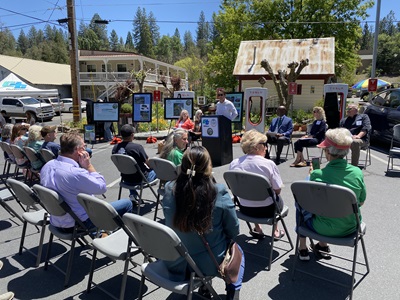
Caltrans officials and local dignitaries spoke at a recent event in Groveland that celebration local projects funded through Clean California.
Photo by District 10By Rick Estrada
District 10 public information officer
A team effort between Caltrans District 10 and our valued partners in Tuolumne County led to a community celebration that shined the spotlight on our Clean California campaign.
Working with Tuolumne County and the Groveland community, District 10 hosted a public event in the High Sierra community of Groveland on May 20, to recognize $1.27 million in Clean California grants that have been awarded for local projects.
District 10’s deputy director for planning, local assistance and environmental support, Marlon Regisford, addressed the gathering, as did Tuolumne County Supervisor Kathleen Haff (District 4); Kim Macfarlane with the Tuolumne County Department of Public Works; Patricia Epp with the Yosemite Highway 120 Chamber of Commerce; and the Tuolumne County Board of Supervisors Chair, Daniel Anaiah Kirk.
One grant will create a pedestrian-friendly State Route 120 and bolster the local economy, a benefit to motorists as well as merchants, by making major upgrades to the parking facility on Ponderosa Lane, just steps from Route 120 in Groveland.
The second grant will modernize Mary Laveroni Park through the addition of a larger restroom, shaded picnic areas and a covered transit center, as well as trails linked to the historic Hetch Hetchy Railroad grade for hiking and exploring.
Caltrans developed the Clean California Local Grant Program and $296 million will go to communities to beautify and improve local streets and roads, tribal lands, parks, pathways, and transit centers to clean and enhance public spaces.
The Route 120 grant will improve pedestrian connections from a tourist parking lot to the highway, which many refer to as “Main Street.” New signage along the highway will promote access to parking and the electric vehicle charging stations.
To enhance the experience, a public restroom will be built with a colorful mural and a tourism kiosk will be added. Trash services will be improved, encouraging people to drop trash in a can rather than tossing it on the ground or on a bench.
Trees will be planted in the adjacent public garden, creating natural shading for folks who want to take a break from the sun. Natural walking trails will also be accessible.
In the parking lot itself, parking spaces will be restriped to improve definition, and a curb will be built along the northern end of the parking lot to redefine the parking lot limits.
“These projects will provide economic benefits for Groveland and the entire region during its construction and afterward,” said Caltrans District 10 Director Dennis Agar. “Travelers will also have a safe, attractive location to park their vehicles and spend some time enjoying ‘Main Street’ in Groveland.”
In District 7, bridges get emergency fixes
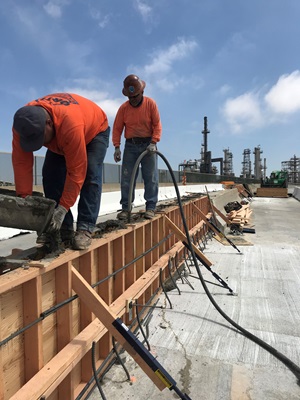
Caltrans workers tend to a bridge in Long Beach that was damaged by a steel-carrying big rig that crashed.
District 7 photographBy Marc Bischoff
District 7 public information officer
District 7 recently had two emergency Director’s Orders for bridge repairs. They were:
- During the first two weeks of May, Caltrans implemented lane closures to perform emergency bridge repairs on State Route 1 (Pacific Coast Highway) crossing over State Route 103 in Wilmington. Unsheltered persons had broken through the concrete of the abutment beneath the bridge deck and created a cave into which they moved. The structural damage in turn created a dangerous sink hole.
- On May 2, a big rig carrying a 48,000-pound roll of steel traveling on northbound State Route 103 lost its load when the trailer broke just north of the juncture with State Route 47 in the Port of Long Beach. The steel bounced across the bridge deck, damaging the bridge deck and girders, guardrail and concrete barrier. For the next six weeks, the left lanes of northbound and southbound SR-103 were closed for emergency repairs. At times all lanes of northbound SR-103 were closed and all lanes of the SR-47 ramp to Henry Ford Avenue were closed. Repairs were completed and all lanes reopened on the afternoon of June 15.
Tools for the Vaccinate All 58 Campaign
From Caltrans Headquarters
Below are some updated links for the Vaccinate All 58 Campaign toolkits and materials. Please feel free to share them with your colleauges.
- VA58 Communications Toolkit Website
- VA58 Toolkit Content on Google Drive
- Masking and COVID-19 Toolkit
- Post-COVID Toolkit
Hats Off
Loving the revamped Highway 101
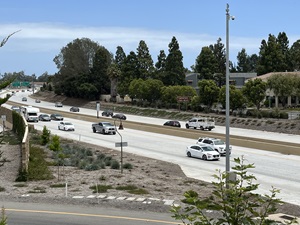
U.S. Highway 101 in Santa Barbara
Photo courtesy of Brett's family
Note: The following email was sent to District 5 on by Josh Newman.
“I just wanted to send a note saying thanks and that I think you are great.
“We drive the 101 here in Santa Barbara all the time. It's our main street. And it gets a little messy, and slow, and things shift. Lanes move. Pavement changes. And then one day ... voila! A brand-new road.
“I know it's not done, but the six lanes in Carpenteria look beautiful.
“And you do it without fanfare, no celebration. Just lanes open, beautiful, and smooth as silk.
“Thank you for all you do. Nowhere is there less recognition for the outsized impact you have on our lives. And I'm really grateful.
“Oh and one more thing: We got a mailing the other day that described what was happening and what was planned and that was also amazing. So grateful that you are as competent and creative as you are. Much appreciated.”
Maintenance crews hailed by Atascaderan
Note: The following letter was sent to District 5’s Nancy Cross and Carolyn Norris on July 11 by Gina Randise of Atascadero.
“I'm writing to thank the dedicated road maintenance workers for their efforts to improve the areas along the Highway 101 corridor in Atascadero. Their commitment and dedication to making the right-of-ways along both sides of the highway safer for travelers is greatly appreciated.
“We know the work is hard and very dangerous. It seems the workers have gone above and beyond to clear brush and debris along the highway in Atascadero.
“Please let the crews know that many of the citizens, they serve, do appreciate their hard work.”
Health and Safety
Fueling your work-life flow: We often bring stress on ourselves by taking on too many commitments

By the Employee Assistance Program
When your life is in balance between home and work, you feel emotionally and physically healthy, able to take things in stride, and positive about the future. However, many people struggle to balance their full-time jobs and personal responsibilities.
The list of demands on our time can seem endless. We’ve all heard the “I don’t have time” excuse before, and it can certainly feel that way when we’ve over-committed or over-scheduled ourselves.
The fact is, we all have the same amount of time each day, and we each make the decision on how we’re going to spend it.
Sometimes not maintaining appropriate work-life boundaries creates overwhelm. Do you check work emails at night or weekends when it’s not necessary to do so? If you work remotely, do you set regular work hours and “unplug” when the workday is over?
Here are some tips to achieve better work-life flow and make the best use of your time:
Prioritize your assignments and activities. Be sure to identify your key assignments and projects on a daily basis and schedule around them first.
Recognize your most productive times and do your most important and challenging tasks then. We have different levels of energy and creativity at different times of the day. Take advantage of your most productive periods.
Minimize distractions. Frequent interruptions eat up productive time and can negatively impact the quality of your work. If possible, check your emails and texts only at certain times, and avoid multi-tasking.
Get rid of clutter. Clutter can sap your time and energy, especially if you find yourself spending time every day looking for things you need. Straighten up your desk/workspace daily. The same goes for online clutter; delete what you don’t need and move on.
Allow some flexibility in your schedule for activities you enjoy and for the unexpected things that always pop up in life. Taking physical and mental breaks will actually help you be more productive and satisfied with your work.
We often bring stress on ourselves by taking on too many commitments and not asking for help, even if we feel overburdened. Are there areas in your work or personal life where you can delegate tasks? Are there other ways you can scale back and not take on as much?
Sometimes we’re driven by a need for perfectionism and we’re reluctant to hand over responsibilities, even when it would provide us much-needed relief.
Who’s New
Ryan Greenway, assistant federal liaison

Ryan Greenway
Ryan Greenway is the new assistant federal liaison in the Director’s Office.
Prior to this position, Ryan served as the Southern California Regional Rail and Transit coordinator for Caltrans’ Division of Rail and Mass Transportation, where he provided technical expertise and strategic policy direction in rail and transit planning. Ryan collaborated with the California State Transportation Agency, Caltrans Headquarters Divisions, districts, and regional funding partners to identify infrastructure priorities and funding programs in alignment with the state’s goals. Prior to joining Caltrans, Ryan served as environmental manager for the California High-Speed Rail Authority, where he led multidisciplinary teams in the development and delivery of two sections of the California high-speed rail system, the largest public works project in the United States. Ryan also worked for Los Angeles County Metropolitan Transportation Agency as a transportation planning manager. He managed the development, environmental clearance, and delivery of complex multimodal corridor projects and funding programs throughout Los Angeles County.
Ryan has a master’s degree in transportation management from the Mineta Transportation Institute at San Jose State University, and a bachelor’s degree in urban and regional planning from California State Polytechnic University, Pomona.
Ryan is a native Californian who enjoys taking rail and transit to explore different cities, biking around Sacramento, and spending time with his spouse and two dogs.
Jeremy Ketchum, chief of Division of Environmental Analysis
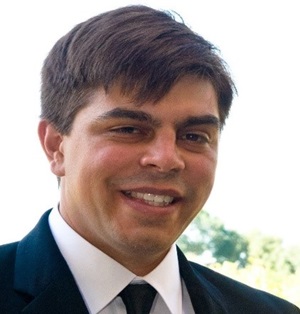
Jeremy Ketchum
Jeremy Ketchum has been appointed chief of the Division of Environmental Analysis.
Jeremy began his Caltrans career as an Environmental Planner for District 4 in 1999. Jeremy then went to North Region where he served first as a generalist and then as a senior.
Beginning in 2012, he joined Headquarters as an environmental coordinator for Districts 4 and 7.
Over the course of his more than 20-year career, Jeremy has had the opportunity to work on many complex projects including the Willits Bypass, Lake 29 Expressway, various carpool projects in the Sacramento area, Solano 80/680/12 Interchange, and served as a member of Team Tahoe.
In his most-recent role as assistant division chief for the Division of Environmental Analysis, Jeremy managed six critical offices: the Environmental Management Office; Biological Science and Innovation; Cultural Studies; Staff Development and Strategic Direction; Biological Studies; and GIS/Web Support, NEPA Assignment, Environmental Management Systems and Inter-Agency/Coastal functions. He also served as the alternate for the transportation secretary as an ex-officio Coastal Commissioner.
Jeremy and his wife, Christina, have one daughter (Jeanna). He enjoys spending time with his family, traveling and rooting for his favorite sports teams including his alma mater, UC Davis Aggies.
Cyndee Kiddoo, District 9 deputy director for administration
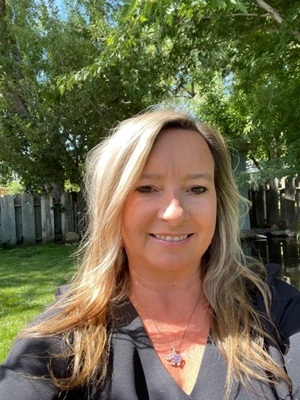
Cyndee Kiddoo
Cyndee Kiddoo has been selected as District 9 deputy director for administration.
Cyndee graduated from Stevens Henager College in Utah with a bachelor’s in healthcare administration in 2006, then went on to obtain a master’s degree in business administration in 2008. In 2022, she also completed a master’s in information technology from Embry Riddle University in Florida.
Cyndee previously worked as the human resources director for the Toiyabe Indian Health project, overseeing numerous department managers and implementing innovative recruitment and performance management initiatives. Cyndee also has extensive right-of-way experience working for Inyo County as an auditor/appraiser, before joining our District 9 team earlier this year as a right-of-way agent.
In her free time, Cyndee enjoys all aspects of the Eastern Sierra including downhill skiing, snowmobiling, and hiking in the summer.
Yatman Kwan, deputy division chief for freight and goods movement

Yatman Kwan
Yatman Kwan is the new deputy division chief for freight and goods movement in the Division of Transportation Planning.
Yatman recently served as the office chief of sustainable freight planning and led statewide freight activities including the development of the California Freight Mobility Plan, California Freight Advisory Committee, multi-state collaboration efforts, freight research, and engagement efforts. He also represents Caltrans on a variety of freight-related committees including those in the American Association of State Highway and Transportation Officials and the Transportation Research Board.
He joined Caltrans in 2007 as a transportation planner in the Local-Development Intergovernmental Review (LD-IGR) Branch in District 4, where in addition to his LD-IGR coordinator role, he also assisted with planning grant administration and complete street activities.
In 2014, Yatman served as the system planning branch chief in District 12, where he led corridor planning, park-and-ride, active transportation, planning grants, freight, special studies, and modeling and forecasting efforts. In 2021, he served as acting deputy division chief for planning and analysis, and acting office chief for air quality and climate change.
Yatman earned his graduate degree in economic development, specializing in transportation, and an undergraduate degree in urban planning from the University of Waterloo, Ontario, Canada.
In his spare time, Yatman enjoys spending time with his wife and very active toddler, traveling to new countries and cities (pre-COVID), learning about culinary history and origins, sampling neighborhood restaurants, and reading.
Tony Tavares, Caltrans director
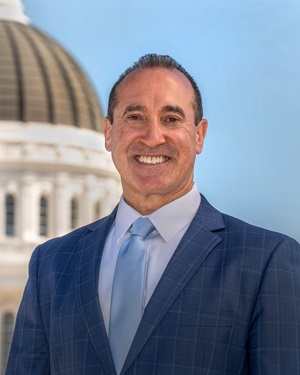
Tony Tavares
Note: The following news release was distributed by the Governor’s Office on June 17.
Governor Gavin Newsom today announced the appointment of Tony Tavares as Director of the California Department of Transportation (Caltrans), where he currently serves as District 7 Director.
“Tony Tavares has dedicated his career to serving the people of California, with decades of leadership and deep experience overseeing critical transportation issues spanning the state,” said Governor Newsom. “I look forward to his continued partnership in advancing our innovative efforts to create safer and more sustainable communities throughout the state.”
Tony Tavares, 55, of Elk Grove, has been District 7 Director of the California Department of Transportation since 2020, where he has served in several positions since 1997, including District 4 Director, Chief of the Division of Maintenance, Chief of the Division of Right of Way and Land Surveys, and Assistant Division Chief of Construction. This position requires Senate confirmation and the compensation is $209,100. Tavares is a Democrat.
Obituaries
Michael “Mike” Eagan, retired project designer
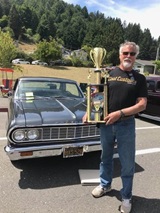
Michael “Mike” Eagan
Photo courtesy of Mike's family
Note: The following email was from Kelly Eagan, chief of the Freight Performance Management Branch in the Division of Transportation Planning.
We are saddened to announce the passing of retired Caltrans employee Michael “Mike” Eagan, who died this spring at the age of 75.
Mike began his career with Caltrans District 1 as a junior engineer in 1965 and retired after over 40 years in 2008 as the design manager for the Eureka and Redding offices. Over the years, Mike oversaw the design of more than 300 projects.
Mike was highly involved with the community where he served as a planning commissioner for the city of Eureka, on the State Board of Professional Engineers, and on the Timber Heritage Association Board. He was also a member of the Historic Preservation Commission, the Humboldt County Historical Society, the Old House Group, and the Humboldt Rose Society. He was a founding member of the Redwood Off road Club, Curry Cruisers, and Lost Coast 4X4s.
Mike is survived by a number of current and past family members who have worked or continue to work for the Department, including Katharine Eagan (wife) in District 1, Kelly Eagan (daughter) at Headquarters, Dr. Nick Compin (son-in-law) at Headquarters, and Tiernan Eagan-Johnson (grandson) in District 1, Jim Everett (nephew) at Headquarters, and Jerry Everett (nephew) in District 3, and proceeded in death by Henry “Michael” Eagan (father) in District 1, Patricia Eagan (sister) at Headquarters.
For information regarding his memorial, please get in touch with Kelly Eagan at kellyeagan@live.com. To read his obituary in the Lost Coast Outpost, click here.
Brett Hall, equipment operator

Brett Hall
Photo courtesy of Brett's family
Note: The following obituary appeared on the Lost Coast Outpost website on July 6.
Equipment operator Brett Austin Hall, born July 23, 1996, in Eureka to Brenda and Richard Hall, passed away peacefully in San Francisco surrounded by the love of his mom, dad, bonus mom Kris and sister Kacie on June 12.
Brett was 25 when he passed after a lengthy battle to breathe, a complication of the chemotherapy he was given to prevent the return of his cancer. It instead, robbed him and us of his life.
Brett had many family roots in Humboldt County and had made Rio Dell his home and where he lived with his two children at the time of his death. Throughout his young life Brett spent time and developed many friendships throughout California, but his love for Trinity County and the family cabin in Ruth was one of his very favorite places to be and where he will forever remain.
Brett was challenged as a young man with many health issues, we his family were always amazed at how he took them, fought bravely, and overcame them. He wanted to be in this life for his family.
Brett had many things he had expressed were important to him, but in the last few months and weeks of his life he felt clarity on what in life was really important, being there for and building a life for his children, Robert and Ashlynn. Being a dad was natural for Brett, these two were his pride and joy, his everything.
Most weekends, you would find him with his kids, whether they were enjoying family BBQs or pool parties, swimming, fishing or kayaking at the river, riding any number of ATV’s, spending time at the lake and giving the kiddos rides on his Sea Doo or simply spending time at the family cabin in Ruth, he felt at home and at peace doing these things. He was always teaching his kids about his love of hunting, fishing, running equipment, trucks and just being in the country.
Brett was proud that he worked for Caltrans, at the time of his passing he was an equipment operator in Leggett, he enjoyed the people he worked with and considered them true friends.
Brett is survived by his children Robert and Ashlynn, his mom Brenda, his dad Richard and bonus mom Kris, his grandparents; Emma, Terry and Walter, his siblings; Kacie, Ashley, Tiffany and Cody, and bonus- siblings Ryan and Chelsea and all their spouses. He was blessed with 16 nieces and nephews many of which he had close relationships with and who helped make his life full. He wouldn’t want us to forget his extended family and the many special friends that made him feel complete.
Brett was preceded in death by his grandparents Ruth and Tony Hall and nephew Caleb Blake.
Gary McSweeney, retired transportation engineer

Gary McSweeney
Photo courtesy of Gary's family
Note: The following obituary appeared on the Couer d’Alene (Idaho) Post Falls Press website on June 17.
Retired transportation planning engineer Gary McSweeney, 82, passed away peacefully at home on May 14 after a long battle with pulmonary fibrosis.
Gary was born Sept. 22, 1939, in South Gate and grew up in Eagle Rock. He met his better half, Janet Svoboda, in 1959. They married in 1961 and went on to have two daughters, Kelley (Aagesen) and Laurie (Damas).
After graduating Eagle Rock High School, Gary joined the U.S. Marine Corps, which he proudly served for 30 years, reaching the rank of Chief Warrant Officer 4.
Gary worked as a transportation planning engineer for the state of California (Caltrans) for 30 years until his retirement in 1994. After retiring, Gary and Jan traveled a bit and ultimately settled down in Hayden, Idaho, in 1996.
Gary accepted Christ as his Savior attending Hayden Friends Church and had an unwavering faith in God which he shared often and loved his One Place Church family.
Gary loved a good “Dad Joke” and always had a new one ready!
Gary was preceded in death by his parents, Bernard McSweeney and Clara Young, younger brother Tom, and beloved in-laws Stan and Marg Svoboda.
Gary is survived by his loving wife, Jan, daughters and sons-in-law Kelley and Mike Aagesen and Laurie and Roy Damas. Grandchildren Christian (Erin) Aagesen, Brian Aagesen, Ann (Ross) Miller and honorary grandson Leland Beckett. Gary found great joy in his great-grandchildren, Lucas and Cooper Aagesen and Emilia and Levi Miller.
Orville Francis Watowa, retired maintenance worker
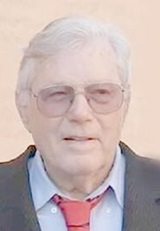
Orville Watowa
Photo courtesy of Orville's family
Note: The following obituary appeared on the Atchison (Kansas) Globe website on July 7.
Orville Francis Watowa, 90, Buena Park, formerly of Atchison, passed away May 15. He was 90.
Orville was born Oct. 11, 1931, son of Lawrence G. Watowa and Phoebe E. (Thrift). He attended St. Benedicts Elementary School and the Good Intent Grade School west of Atchison and Atchison County Community High School, Effingham, Kansas.
He enlisted in the Navy in Oct. 1951, as a gunner mate during the Korean War, until his honorable discharge on Oct. 11, 1955. After serving in the military, a year later, he married and moved to Simi Valley in 1957, then to Buena Park in 1969.
He worked as a Light and heavy equipment operator in supervisory and lead roles for over 36 years for the State of California Highway Department (Caltrans), until his retirement on Dec. 31, 1996.
Orville is survived by: two sons, Travis E. Watowa, Anaheim, California, Monty A. Watowa, Buena Park; three daughters: Tammy M. Neumann, Platte City, Missouri, Renee F. LaCorte, Corona; Kristen K. Watowa, Temecula; two brothers, Jerome (Jerry) Watowa, Topeka, Kansas, Donald Watowa, Sterling, Alaska; and one sister, Doris Smith, Atchison.
Orville is preceded in death by: both his parents; former wife, Delores M. Watowa (Benshoof); one daughter, Tina J. Watowa; and two brothers, Robert (Bob) Watowa, Jim Watowa, Atchison.
He treasured his six children, 10 grandchildren, four great-grandchildren and all of our family friends (as his own).
He was a farmer, construction worker, master mechanic by nature, heavily involved throughout his lifetime and passionately entrenched in all of his communities, in so many ways. Orville was a perpetual helper.

